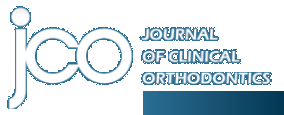Search Results For: 'orthodontics'
3621.
Volume 16 : Number 4 : Page 269 : Apr 1982
Variation in the relationships of tooth sizes in the upper and lower jaws, in the angulations of the facial surfaces of the teeth, and in the relationships, sizes, and inclinations of the apical bases...
3622.
Volume 17 : Number 8 : Page 529 : Aug 1983
Since the mid-1970s, many improvements have been made in indirect bonding technique, including better bracket design, better adhesive systems, and a number of useful additions to both the laboratory a...
3623.
CASE REPORT
The Modified Harvold Activator
Volume 18 : Number 9 : Page 650 : Sep 1984
Although the effectiveness of functional appliances in changing the skeletal growth pattern is still subject to much debate, we find the activator to be successful in treating mild Class II discrepanc...
3624.
Effects of Enamel Etching Time on Bond Strength and Morphology
Volume 19 : Number 1 : Page 36 : Jan 1985
One-minute conditioning of enamel has become standard practice in bonding technique. A clear trend is emerging that suggests the time of acid conditioning in bonding procedures can be reduced, to redu...
3625.
Volume 19 : Number 2 : Page 128 : Feb 1985
A high percentage of young children with severe overjet and overbite suffer fractured maxillary incisors, making it important to act at an early age--6-9 years--in such cases to try to avoid the probl...
3626.
Volume 20 : Number 4 : Page 0 : Apr 1986
The Porta-Stat, a portable cephalometric and arthrometric cephalostat, was designed to take standardized craniofacial and TMJ x-rays of infants and infirm patients in the clinician's office, the opera...
3627.
CASE REPORT
Distalization of Molars with Repelling Magnets
Volume 22 : Number 1 : Page 0 : Jan 1988
Class II malocclusions, which are the most numerous among orthodontic cases,1 can be resolved by several procedures. One involves the distal movement of the maxillary molars to establish Class I molar...
3628.
Psychological Aspects of Prolonged Thumbsucking Habits
Volume 22 : Number 8 : Page 0 : Aug 1988
Dental deformities and malocclusions are often caused by prolonged finger- or thumbsucking. This behavior has historically been explained by either a psychoanalytical or a behavioristic approach.1-14 ...
3629.
Direct Bonding with Glass Ionomer Cement
Volume 24 : Number 8 : Page 0 : Aug 1990
Fluoride-releasing composite resins have recently been introduced for direct bonding, in an effort to reduce the possibility of decalcification during orthodontic treatment. However, these resins rely...
3630.
A Sliding Bridge Appliance for Space Closure
Volume 25 : Number 2 : Page 0 : Feb 1991
The distance between abutments--bridge span--has an important influence on the durability of fixed prostheses. Loading of the abutment and the bridge is more than proportional to the bridge length.1 T...
3631.
A New Instrument for Debonding Clean-Up
Volume 25 : Number 7 : Page 0 : Jul 1991
Failure to remove all composite from enamel surfaces after debonding will result in "flat spots" that do not reflect light to the same degree as the surrounding enamel, or in composite ledges that can...
3632.
Rapid Alignment with a High-Tensile Wire
Volume 28 : Number 2 : Page 0 : Feb 1994
This article describes the rapid leveling and alignment that can be achieved with the pulse-straightened (gold label) Supreme grade of .009" Australian wire. The wire's reduced diameter, which makes i...
3633.
Effect of a New Bonding Agent on Bond Strength to Saliva-Contaminated Enamel
Volume 28 : Number 2 : Page 0 : Feb 1994
When a bond failure occurs during initial archwire placement, it is likely to be the result of moisture contamination of the bonding site.1,2 Both in vitro and in vivo studies have demonstrated that m...
3634.
Optimal Light Curing of Adhesive Precoated Brackets
Volume 29 : Number 9 : Page 0 : Sep 1995
Both in vivo and in vitro testing have shown that the use of light-cured adhesives for bonding orthodontic brackets should produce bond strengths and failure rates similar to those of chemically cured...
3635.
Twist Ligation: A Technique to Reduce Archwire Binding
Volume 30 : Number 3 : Page 0 : Mar 1996
Differential anchorage is necessary when sliding mechanics must be applied asymmetrically. There is probably a linear relationship between stress (force per unit area) and tooth movement.1 However, be...
3636.
Fixed Biteplanes for Treatment of Deep Bite
Volume 30 : Number 5 : Page 0 : May 1996
Bite-opening procedures are usually instituted early in treatment, both to maximize patient cooperation and to allow anteroposterior tooth movements that might otherwise be hindered by the deep bite. ...
3637.
Treatment of Deep Bite with Bonded Biteplanes
Volume 30 : Number 7 : Page 0 : Jul 1996
Bonded biteplanes can be used in Class I and Class II, division 1 and 2 cases for the correction of deep bite with moderate overjet. The shape of these biteplanes was inspired by that of the lingual o...
3638.
CASE REPORT
Asymmetric Mandibular Space Closure
Volume 30 : Number 9 : Page 519 : Sep 1996
Space closure in the posterior segment of the mandibular arch is a difficult procedure under any circumstances, particularly in Class II cases. If the problem is unilateral, requiring asymmetric mecha...
3639.
Disinfection of Permanent Markers
Volume 30 : Number 11 : Page 646 : Nov 1996
The Sharpie* fine-point permanent marker can be used in making bite registrations,1 noting treatment objectives on radiographs, and marking areas that need adjustment on removable appliances.2 Its mos...
3640.
Argon Laser for Light-Curing Adhesives
Volume 31 : Number 6 : Page 371 : Jun 1997
The extended placement time offered by light-cured adhesives allows more accurate bracket positioning. The major disadvantage of these adhesives has been the 20 to 40 seconds required to set each brac...
Showing 3621-3640 of 4092 results. Search completed in 0.085 seconds.

